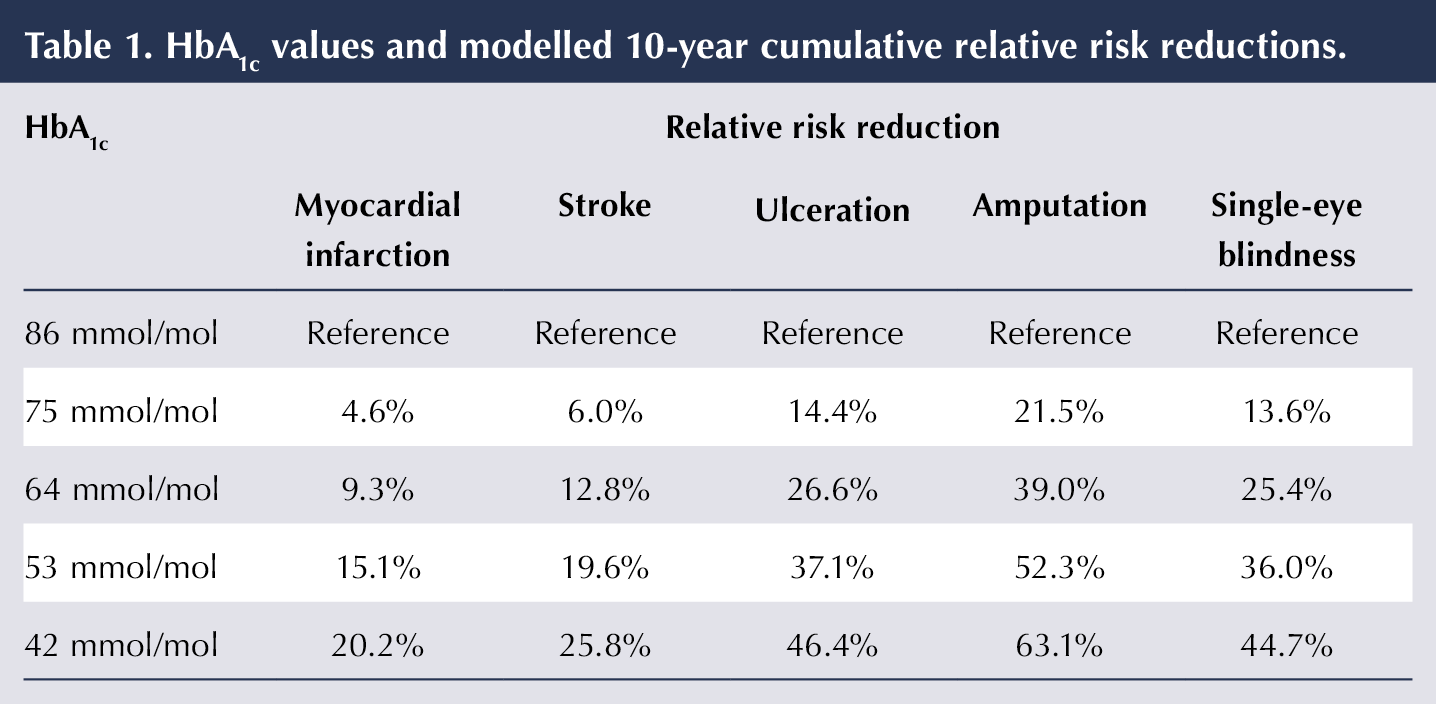Modelling the effects of different HbA1c targets on diabetes complications
Mostafa SA et al (2018) Diabet Med 35: 72–7
This article modelled the degree to which targeting different HbA1c reductions might reduce the risk of diabetes-related complications. Using data from the TECOS trial, micro- and macrovascular complication rates were estimated with HbA1c levels of 86, 75, 64, 53 and 42 mmol/mol (10%, 9%, 8%, 7% and 6%) while holding other risk factors constant at their baseline levels. Ten-year cumulative relative risk reductions for the modelled HbA1c values are shown in Table 1.
These simulated complication rates might help inform the degree to which complications could be reduced by targeting specific HbA1c levels in people with type 2 diabetes.
Fasting glucose and all-cause mortality risk by age
Yi SW et al (2018) Diabetes Care 41: 623–26
This study looked at the associations between fasting plasma glucose (FPG) levels and mortality in Korean adults with diabetes. The FPG levels associated with the lowest mortality were 5.0–7.2 mmol/L, except for in those aged 18–44 years, in whom the optimal level was 4.5–5.2 mmol/L. Tighter glucose control thus lessens the risk of premature death in younger adults with diabetes.
Hypoglycaemia was associated with higher mortality than was an FPG of 9.5–11.0 mmol/L, while an FPG of 3.6–4.6 mmol/L had risks comparable with those at levels 7.8–9.4 mmol/L. The optimal FPG ranges were approximately 5.0–7.2 mmol/L, except in younger adults aged 18–44 years, who had similar optimal ranges to individuals without known diabetes. Avoidance of low-normal levels (3.6–4.6 mmol/L) and hypoglycaemia may improve survival in people with diabetes.
Factors associated with attendance at pre-pregnancy care and reasons for non-attendance among women with diabetes
Morrison M et al (2018) Diabetes Res Clin Pract 142: 269–75
These authors sought to describe the factors associated with uptake of diabetes-specific pre-pregnancy care (PPC) and to determine the reasons for non-attendance.
Of 429 eligible women, 54% reported having attended PPC. In multivariable logistic regression analysis, having type 1 diabetes, being married or in a relationship, tertiary education and employment were associated with greater likelihood to attend PPC. Overall, 68% rated PPC as helpful. A lack of awareness about the availability of PPC (48%) and unplanned pregnancy (47%) were the main reasons for non-attendance. Of women with future pregnancy plans, 43% were aware of local services offering PPC and 84% indicated they would attend PPC if available.
Reasons reported for non-attendance suggest that strategies to increase awareness about the availability of diabetes-specific PPC and the risks of unplanned pregnancy are warranted.
Flash glucose monitoring beneficial over 2 years in type 1 diabetes
Londahl M et al (2018) Diabetes 67(Suppl 1): A249 (abstract 958-P)
The aim of this study was to evaluate the long-term effects of flash glucose monitoring (FlaGM) on HbA1c and treatment satisfaction in people with type 1 diabetes.
Of 334 people who started on FlaGM, 80.5% were still users after 2 years, 8.7% changed to a continuous glucose monitoring system, 6.6% stopped due to skin reactions, 3.4% did not want to continue and 1.3% had died. Compared with baseline, HbA1c was 9.0±11.8 mmol/mol lower after 2 years. Both high and low blood glucose levels were less common.





Study provides new clues to why this condition is more aggressive in young children.
14 Nov 2025